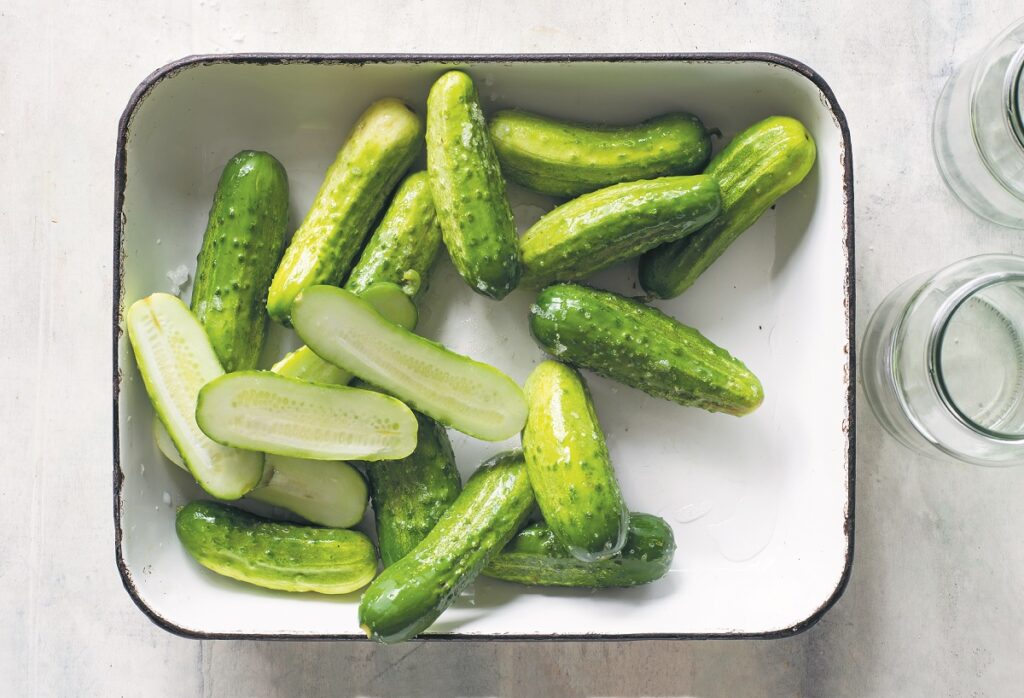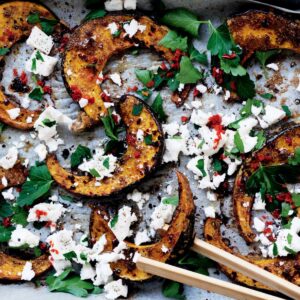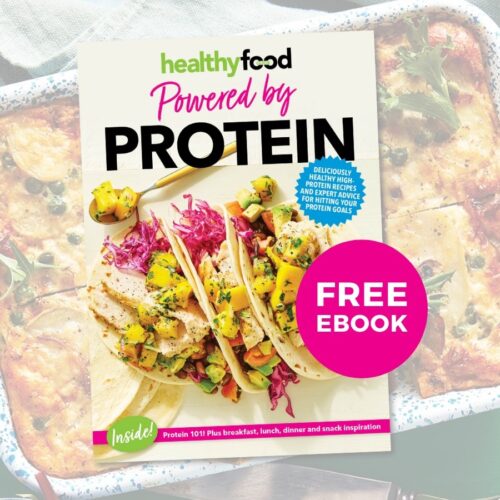

Gherkins
This is an edited extract from Pocket Pickler: Essential recipes for pickles, chutneys, relishes and more by Alex Elliott-Howery. Published by Murdoch Books RRP$29.99
Ingredients
- 1.2kg small gherkins (pickling cucumbers)
- 1 tablespoon salt
- 625ml white wine vinegar
- 310ml water
- 55–110g caster sugar, depending on how sweet you like your pickles
- 2 teaspoons salt
- For each jar
- ¼ teaspoon whole black peppercorns
- 1 teaspoon dill seeds
- ¼ teaspoon dried dill
- 1 teaspoon mustard seeds
Log In or Sign Up to save this recipe to your shopping list.
Instructions
1 Wash gherkins and remove any blemished ends or flowers that are still attached. If your gherkins are different sizes, cut the big ones in half so they’re all similar in size.
2 Put the gherkins in a non-reactive bowl and sprinkle with the 1 tablespoon salt. Leave to sit overnight in the fridge. You need to do this in order to draw out excess moisture, or your brine will be too watery. It also helps your pickles keep their crunch.
3 The next day, strain off and discard any liquid.
4 Sterilise jars and lids (see HFG tip).
5 In a non-reactive*, medium-sized saucepan, make your brine by combining vinegar, water, sugar and the 2 teaspoons salt. Place over low heat and stir to dissolve the sugar. Increase the heat and bring to the boil.
6 When the jars are cool enough to handle, add the spices to each jar. Carefully pack the gherkins vertically in the jars. Add the hot brine to completely cover the gherkins. Then add a few more gherkins to each jar, laying them horizontally on top to hold the other gherkins down under the brine.
7 Remove any air bubbles by gently tapping each jar on the work surface and sliding a clean butterknife or chopstick around the inside to release any hidden air pockets. You may need to add more brine to ensure the gherkins are fully submerged. Wipe the rims of the jars with paper towel or a clean damp cloth and seal. Heat-process (see HFG tip) for 15 minutess, then let sit for 2 months before opening. Store in a cool, dark place for up to 2 years. Once opened, refrigerate and use within 6 months.
Serving suggestion
Store up to 2 years
HFG tip
Sterilising jars and bottles:
To sterilise jars or bottles, give them a wash in hot soapy water and a good rinse, then place them upright in a baking dish in a cold oven. Heat the oven to 110°C and, once it has reached temperature, leave the jars in the oven for 10–15 minutes, or until completely dry, then remove carefully.
For hot packing, pour the hot mixture straight into the hot jars; for cold packing, allow the jars to cool before adding your pickles or preserves.
To sterilise the lids, place them in a large saucepan of boiling water for 5 minutes, then drain and dry with clean paper towels, or leave them on a wire rack to air dry. Make sure they are completely dry before using.
Heat-processing:
1 Also called water bathing or canning, this process uses heat to stop the growth of bacteria. It generates pressure inside the preserving jar or bottle, which forces out any oxygen, creating an uninhabitable environment for microorganisms, lengthening the shelf life of preserves, and providing a proper seal.
2 Get the biggest pan you have, such as a stockpot – the taller, the better – and put it on the stovetop.
3 Lay a folded tea towel in the bottom of the pan, then sit your jars on the tea towel, taking care not to cram them in, and keeping them clear of the sides of the pan. (All these measures are to stop the jars from wobbling around and cracking as the water boils.) Roughly match the water temperature to the temperature of the jars (to help prevent breakages from thermal shock), then pour in enough water to cover the jars, either completely or at least until three-quarters submerged.
*Non-reactive cookware means it doesn’t react to acid or chemicals in food. Choose stainless steel, ceramic and glass, and avoid copper, cast iron or aluminium.
Nutrition Info (per serve)
-
Calories 8 cal
-
Kilojoules 35 kJ
-
Protein 1 g
-
Total fat 1 g
-
Saturated fat 1 g
-
Carbohydrates 1.4 g
-
Sugar 1.4 g
-
Dietary fibre 1 g
-
Sodium 210 mg
-
Calcium 4.4 mg
-
Iron 1 mg
© Healthy Food Guide All rights reserved. Reproduction without written permission prohibited.
Sign up for the  newsletter
newsletter
Delicious recipes and expert health advice you can trust, delivered to your inbox.
More recipes you may like
Makeover recipes
Advertisement
Vegetarian
Advertisement
Side Dishes
Advertisement
RELATED ADVICE LATEST ADVICE
















